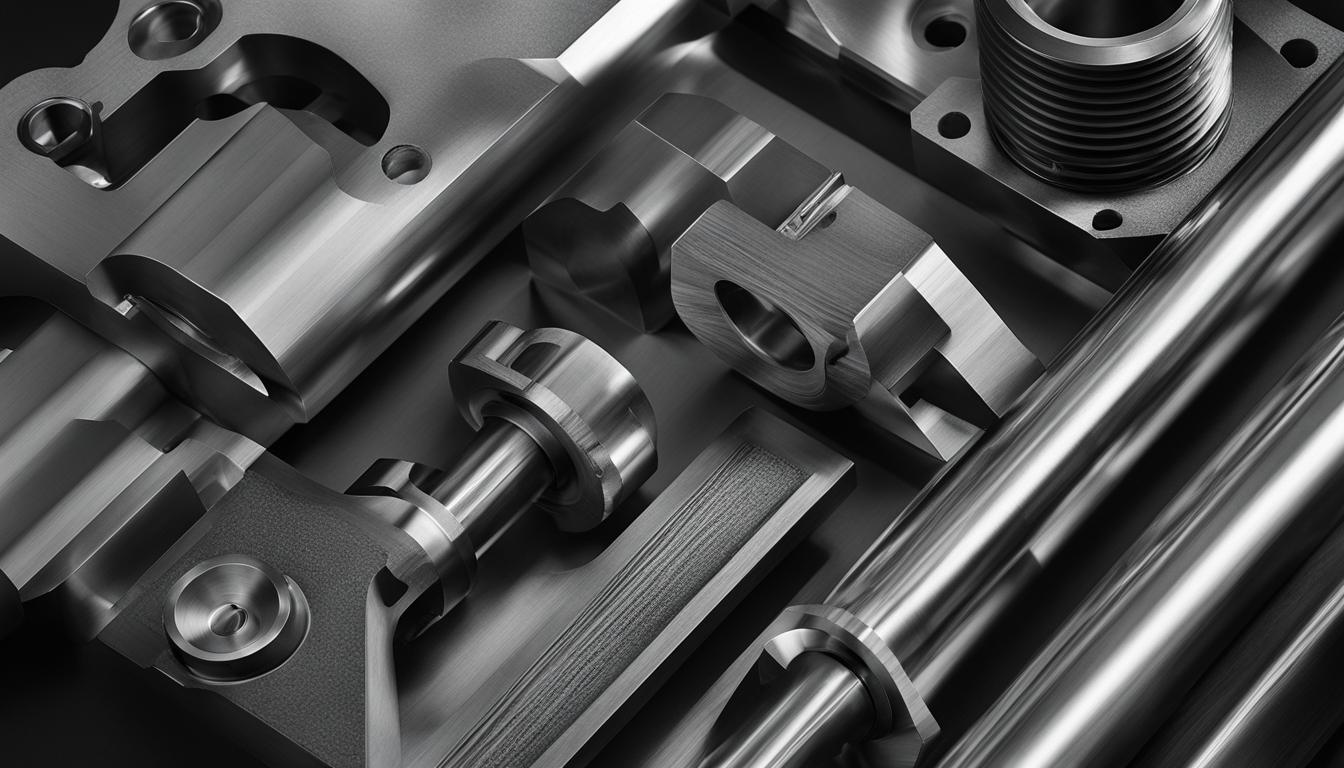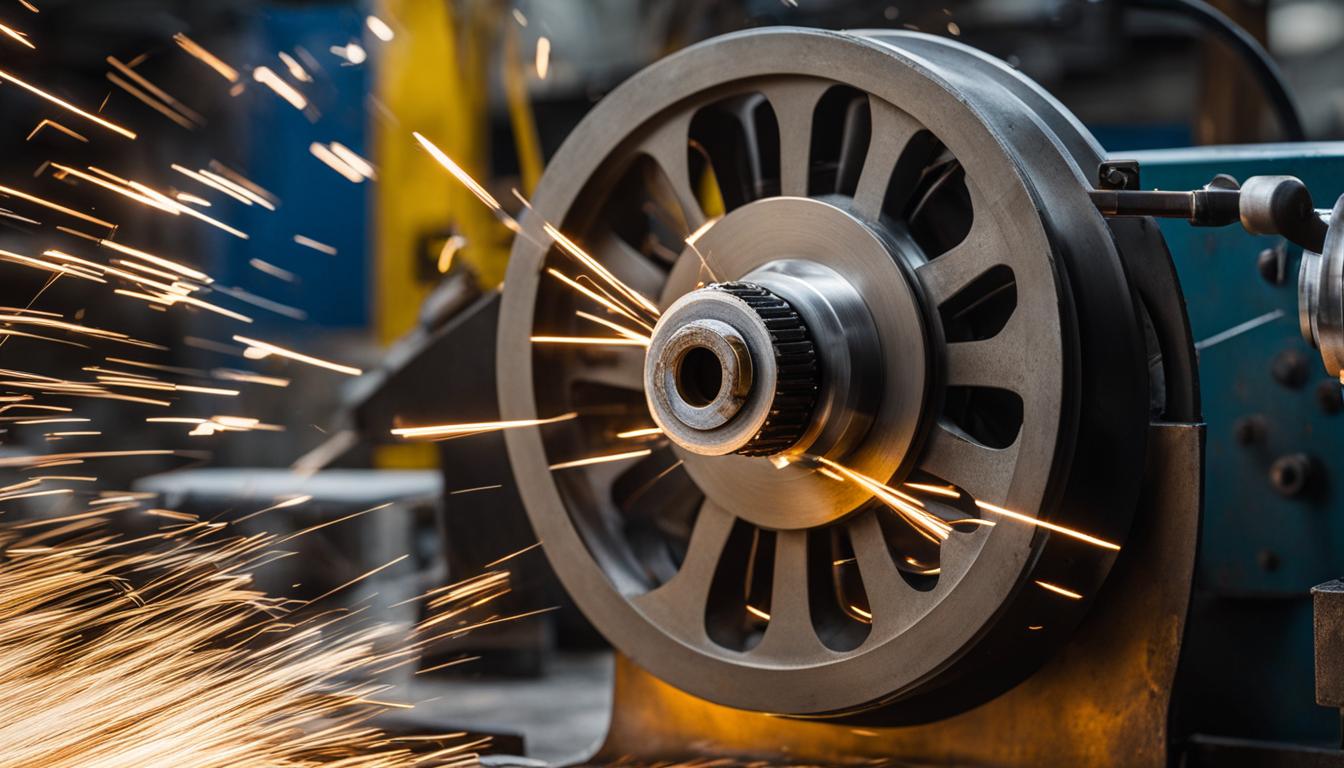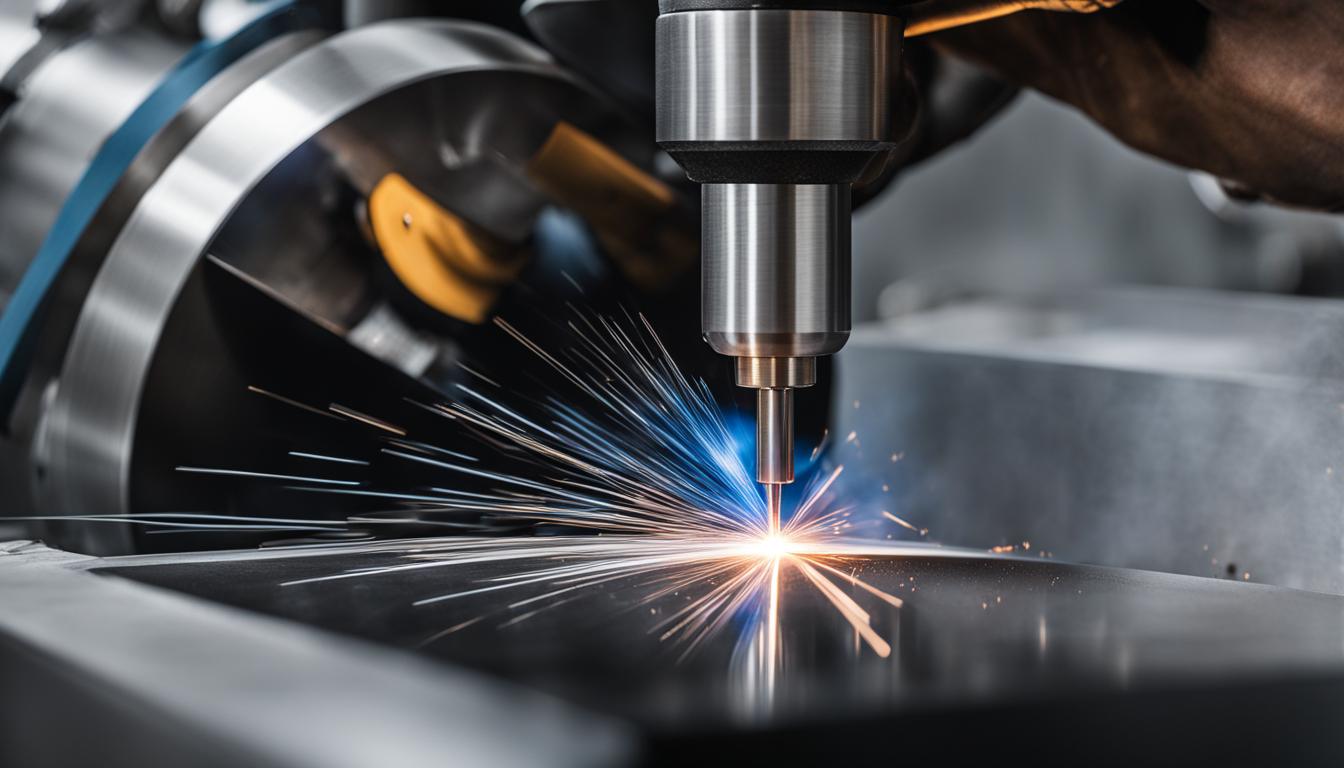In the machining industry, grinding and turning are two distinct manufacturing processes that play a crucial role in shaping workpieces. Understanding the differences between grinding and turning is essential for manufacturers to determine the most suitable process for their specific needs. This article will explore the similarities and differences between grinding and turning, as well as the advantages and benefits each process offers.
What is Grinding?
Grinding is a material removal process that utilizes an abrasive wheel as a cutting tool. It is commonly used to achieve high levels of surface finish and dimensional accuracy. The grinding process is versatile and can be applied to a wide range of materials, including both metals and non-metallic materials.
One of the key advantages of grinding is its ability to create intricate profiles and contours, making it suitable for complex workpieces that require precision. By carefully controlling the grinding parameters, manufacturers can achieve the desired surface finish and dimensional tolerances for their products. As a result, grinding is often chosen for applications where precision and quality are paramount.
Grinding can be performed using various types of grinding machines, such as cylindrical grinders, surface grinders, and centerless grinders. Each machine is designed to handle specific workpiece geometries and surface finishing requirements.
What is Turning?
Turning is a machining process that involves rotating the workpiece while a cutting tool removes material from it. It is commonly used for shaping cylindrical or conical parts in the manufacturing industry. The turning process utilizes single-point cutting tools to achieve precision and accuracy in removing material from the workpiece.
One of the key advantages of turning is its suitability for machining workpieces that have been heat-treated or have high hardness. Turning can effectively handle materials with different levels of hardness, making it a versatile process for various applications.
Furthermore, turning offers several advantages that contribute to its popularity in the machining industry. It is a cost-effective process as it utilizes standard off-the-shelf insert style tooling, which reduces tooling costs. Moreover, turning provides flexibility in handling different workpiece sizes and shapes, making it suitable for a wide range of machining requirements.

| Advantages of Turning |
|---|
| Cost-effectiveness |
| Versatility in handling various workpiece sizes and shapes |
| Reduction in tooling costs |
Advantages of Grinding over Turning
Grinding offers several distinct advantages over turning in certain applications. It delivers high precision and exceptional surface finish, making it the ideal choice for critical components that require tight tolerances. With its versatility, grinding can create complex shapes and profiles that may be challenging with other machining methods. Moreover, grinding can be applied to a wide range of materials, including ceramics and composites, adding further flexibility to the manufacturing process.
To elaborate on the advantages of grinding over turning, let’s examine each aspect in detail:
Precision:
Grinding achieves outstanding precision, surpassing the capabilities of turning when it comes to dimensional accuracy. The use of an abrasive wheel allows for fine adjustments and meticulous control, ensuring that the desired measurements are met with exceptional accuracy.
Surface Finish:
Surface finish is another area where grinding excels. With its abrasive action, grinding can produce smooth and uniform surfaces, resulting in superior aesthetic appeal and reduced friction. This is particularly crucial for components that require optimal contact surfaces, such as bearings or sealing elements.
Complex Shapes:
Grinding allows for the creation of intricate profiles and complex shapes that may be difficult to achieve through other machining processes. The versatility of grinding machines and the wide variety of available abrasives enable manufacturers to produce workpieces with unique and intricate geometries.
Tight Tolerances:
The ability to achieve tight tolerances is a significant advantage of grinding over turning. Grinding machines can provide the precision required for components with extremely narrow tolerances, ensuring that the final products meet the required specifications without compromise.
Considering the exceptional precision, superior surface finish, ability to handle complex shapes, and the capability to achieve tight tolerances, grinding stands as a preferred choice in various manufacturing applications. The next section will explore the benefits of turning compared to grinding in specific scenarios.
Benefits of Turning Compared to Grinding
While grinding and turning are both valuable machining processes, turning offers specific advantages when compared to grinding depending on the scenario. Let’s explore the key benefits of turning:
- Cost-Effectiveness: Turning is generally a more cost-effective option compared to grinding. This is because turning utilizes standard off-the-shelf insert style tooling, eliminating the need for expensive form grinding wheels.
- Faster Process: Turning is known for its time-efficient nature. The process is typically faster than grinding, resulting in shorter production cycles. This not only saves time but also contributes to overall cost savings.
- Reduced Tooling Costs: By using standard insert style tooling, turning significantly reduces tooling costs. Manufacturers can avoid the expense of custom grinding wheels and instead rely on readily available insert tools for their turning operations.
- Manufacturing Process Flexibility: Turning provides flexibility in the manufacturing process by allowing multiple operations to be performed in a single setup on a turning center. This eliminates the need for additional grinding processes, streamlining the production flow and reducing costs.
Overall, turning offers a cost-effective and faster process, along with reduced tooling costs and manufacturing process flexibility. These benefits make turning a preferred choice in certain scenarios, enabling manufacturers to optimize their production operations.
Example:
| Advantages of Turning | Advantages of Grinding |
|---|---|
| Cost-effective | Precision and surface finish |
| Faster process | Ability to create complex shapes |
| Reduced tooling costs | Versatility in materials |
| Manufacturing process flexibility |
Applications of Grinding
Grinding is a versatile machining process that finds its applications in various industries and finishing operations. By utilizing abrasive wheels, grinding can achieve precise results and high-quality surface finishes. Let’s explore some of the key applications where grinding excels:
1. Finishing Operations on Hardened Steel Components
After heat treatment, hardened steel components often require precision finishing to meet dimensional and surface finish requirements. Grinding offers the necessary accuracy and control to achieve the desired results. It is commonly used in industries such as automotive, aerospace, and tool manufacturing for finishing operations on gears, shafts, and bearings.
2. Precision Grinding for Cylindrical and Flat Surfaces
Precision grinding is essential when manufacturing components with high tolerance requirements and premium surface finishes. It allows for the creation of precise cylindrical and flat surfaces, ensuring dimensional accuracy and smoothness. Industries such as medical device manufacturing, mold-making, and precision engineering heavily rely on precision grinding to produce intricate and high-quality parts.
3. Sharpening Cutting Tools
Grinding is widely used for sharpening various cutting tools, including drills, end mills, and lathe tools. The abrasive wheels remove material from the tools’ edges, restoring their sharpness and enhancing their cutting performance. This application is crucial in industries such as metalworking, woodworking, and fabrication, where sharp and efficient cutting tools are essential for optimal productivity.
4. Achieving a Premium Surface Finish on Different Materials
Grinding is capable of achieving superior surface finishes on a wide range of materials, including metals, ceramics, and composites. This makes it an ideal choice for industries such as mold-making, optics, and electronics, where a flawless surface finish is crucial for the functionality and aesthetics of the final product. The precision and control offered by grinding ensure that the desired surface finish requirements are met consistently.
Grinding applications cater to diverse industries and specialized machining requirements. Whether it’s finishing operations on hardened steel components, precision grinding for dimensional accuracy, or achieving premium surface finishes, grinding plays an integral role in various manufacturing processes.
| Industries | Applications |
|---|---|
| Automotive | Gears, shafts, bearings |
| Aerospace | Turbine components, landing gear |
| Medical Device Manufacturing | Precision components, implants |
| Mold-making | Molds, dies |
| Metalworking | Cutting tools, precision components |

Applications of Turning
Turning is a versatile machining process that finds diverse applications across various industries. It offers precise and efficient solutions for machining hardened steel components, automotive parts, aerospace components, and precision machining of molds, tools, and dies.
Machining Hardened Steel Components
Turning is often utilized for machining hardened steel components, including gears, shafts, and bearings. The process enables the creation of intricate profiles and precise dimensions on these components, ensuring optimal performance and durability.
Automotive Parts Production
Automotive manufacturers rely on turning for the production of various parts, such as CV joints and transmission components. Turning offers a cost-effective and efficient solution for machining these components, meeting the high-quality standards required in the automotive sector.
Aerospace Component Manufacturing
In the aerospace industry, turning plays a vital role in the machining of critical components like landing gear and turbine shafts. The process ensures the necessary precision, tight tolerances, and surface finish required for aerospace applications, guaranteeing the safety and reliability of aircraft.
Precision Machining of Molds, Tools, and Dies
Turning is also widely employed in precision machining operations involving molds, tools, and dies. The process enables the creation of complex shapes and precise details, ensuring the highest quality and functionality of these crucial tools in various industries.
Applications of Turning
| Industry | Turning Applications |
|---|---|
| Automotive | CV joints, transmission components |
| Aerospace | Landing gear, turbine shafts |
| Manufacturing | Hardened steel components, molds, tools, and dies |
Choosing the Suitable Process
When it comes to selecting the most suitable machining process for your manufacturing needs, there are several factors to consider. These factors include material hardness, dimensional tolerances, surface finish requirements, and production volume. By carefully analyzing these elements, manufacturers can make an informed choice between grinding and turning.
If high precision and exceptional surface finish are critical for your application, grinding is the preferred method. Grinding utilizes an abrasive wheel to remove material, allowing for precise shaping and fine finishes. This process is particularly advantageous when working with materials that demand tight tolerances and intricate designs.
On the other hand, turning offers cost-effective and faster processes, making it an attractive option for certain applications. During turning, a cutting tool removes material from a rotating workpiece. It is a versatile method that can handle various workpiece sizes and shapes, reducing tooling costs by using standard off-the-shelf insert style tooling.
To illustrate the decision-making process, consider the following scenarios:
Scenario 1: Material Hardness
If you are working with a material that has high hardness, such as hardened steel, turning may be the ideal choice. Turning is well-suited for machining hardened materials, delivering efficient results with reduced tooling costs.
Scenario 2: Dimensional Tolerances
For components that require tight dimensional tolerances, grinding is the recommended process. Grinding excels in achieving precise measurements, ensuring accuracy and consistency in the final product.
Scenario 3: Surface Finish Requirements
If your application demands a superior surface finish, grinding is the go-to method. Grinding can achieve exceptional surface quality, enhancing both the appearance and functionality of the workpiece.
Scenario 4: Production Volume
The production volume also plays a role in choosing the suitable process. Grinding is well-suited for smaller production runs that require high precision, while turning is efficient for larger volume production due to its faster process.
By carefully assessing material hardness, dimensional tolerances, surface finish requirements, and production volume, manufacturers can determine whether grinding or turning is the most appropriate process for their specific needs. This analysis ensures optimal results and the efficient use of resources.
Grinding vs Turning: Key Differences Explained
Grinding and turning are distinct but complementary machining processes in the manufacturing industry. While both methods involve material removal from a workpiece, there are key differences that manufacturers need to consider when choosing the optimal process for their specific applications.
Grinding is known for its ability to achieve precise surface finishes and create complex shapes. It utilizes an abrasive wheel to remove material from the workpiece’s surface, allowing for high levels of precision and intricate profiles.
On the other hand, turning is a more cost-effective and faster process. It involves rotating the workpiece while a cutting tool shapes it, making it suitable for handling various workpiece sizes and shapes. Additionally, turning eliminates the need for additional grinding processes, reducing production costs.
Manufacturers should assess their requirements to determine which machining process is most suitable for their applications. Grinding is ideal for critical components that require high precision and intricate profiles, while turning offers versatility, cost-effectiveness, and faster production times.
| Grinding | Turning |
|---|---|
| Excels in achieving precise surface finish | Cost-effective and faster process |
| Capable of creating complex shapes | Versatility in handling various workpiece sizes and shapes |
| Suitable for critical components that require high precision | Eliminates the need for additional grinding processes, reducing production costs |
By understanding the differences between grinding and turning, manufacturers can make informed decisions and choose the most suitable process that aligns with their specific needs and requirements.
Expert Insights and Experience
Industry experts offer valuable opinions and insights on the benefits and applications of grinding and turning processes. Their expertise sheds light on the advantages that each process brings to the manufacturing industry.
Precision and Surface Finish
Experts highlight the exceptional precision and superior surface finish achieved through grinding. The use of abrasive wheels allows for meticulous material removal, resulting in highly accurate dimensions and smooth surfaces. This makes grinding an ideal choice for applications that demand tight tolerances and impeccable surface quality.
Cost-Effectiveness and Flexibility
Turning, on the other hand, is praised for its cost-effectiveness and flexibility. Industry professionals emphasize that turning offers a faster production process compared to grinding, making it a more efficient option for certain applications. Moreover, turning utilizes standard off-the-shelf insert style tooling, reducing tooling costs and increasing overall cost efficiency for manufacturers.
Considerations for Choosing Between Grinding and Turning
Experts stress the importance of considering various factors when deciding between grinding and turning. Material hardness, dimensional tolerances, and production volume play a crucial role in determining the most suitable process. Carefully evaluating these factors is paramount to ensuring precise results, efficient production, and cost-effectiveness.
Insights from industry professionals provide valuable guidance and inform manufacturers’ decisions when choosing between grinding and turning processes. By leveraging the expertise and experience of these industry leaders, manufacturers can optimize their machining operations and achieve superior results.
Conclusion
Grinding and turning are two essential manufacturing processes that offer distinct advantages and applications. Understanding the differences between these processes is crucial for manufacturers to choose the most suitable method based on their specific requirements.
Grinding excels in achieving high precision and surface finish, making it ideal for critical components that demand tight tolerances. It also allows for the creation of complex shapes and profiles, providing versatility in manufacturing. On the other hand, turning offers a cost-effective and faster process, making it advantageous for high-volume production. Turning is also versatile in handling various workpiece sizes and shapes, reducing the need for additional grinding processes and tooling costs.
Ultimately, manufacturers should carefully evaluate their needs, considering factors such as material hardness, dimensional tolerances, surface finish requirements, and production volume, to determine whether grinding or turning is the optimal process. By leveraging these machining methods effectively, manufacturers can achieve desired results, meet their unique manufacturing needs, and ensure the success of their projects.
